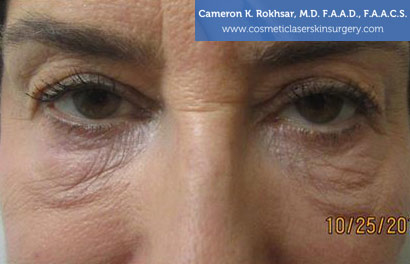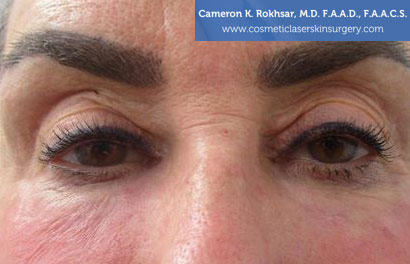Fixing botched Botox injections in New York
What do you do when your Botox treatment migrates to the incorrect area and causes drooping eyelids? You consult one of New York Magazine’s1 top dermatologists and cosmetic surgeons, Dr. Cameron Rokhsar. He is a sought-after dermatologist serving patients throughout Manhattan, Long Island, and NYC and has helped many reverse the effects of a botched Botox treatment.
What Happens When Botox Goes Wrong?
While, in the hands of an experienced, board-certified dermatologist, Botox injections can eliminate the effects of aging, such as wrinkles and fine lines. It can also cause some unsightly complications, especially when injected by an inexperienced injector2.
An example of such is when your treatment is meant to soften frown lines and wrinkles on your forehead, but instead, your injector gets the injection location wrong. Resulting in the botulinum toxin type A migrating to your eyelid muscles, causing Botox-induced eyelid ptosis3.
Identifying Botched Treatment
Dr. Rokhsar has trained many physicians on Botox injection techniques. He is one of the best dermatologists to consult with if you are unhappy with the results from your previous treatment provider.
He sees 10 or more patients daily for Botox treatment, with some of his patients presenting with:
- Limited facial movements due to over-injection
- “Spock” brow, where their eyebrows look unnatural
- Droopy or heavy eyebrows due to migration
These are all signs of botched neurotoxin treatment. Fortunately, in some cases, Dr. Rokhsar can reverse the effects of botched treatment for patients throughout Manhattan, Long Island, and the New York area.
Treatment Options For Botched Botox In NYC
Dr. Cameron Rokhsar believes that cosmetic dermatology should boost self-confidence and not take away from it. Patients are treated like family, with patient safety and high quality of care at the top of his priority list.
He confidently approaches botched treatment with the intent to support his patient as best as possible. While in most cases it is advisable to wait it out, there are certain instances where treatment can reverse the unsightly outcome, such as droopy eyelids due to incorrect treatment that can be treated with certain eye drops.
FDA-approved Upneeq4 eye drops stimulate eyelid muscle contractions thanks to oxymetazoline, an alpha-adrenergic agonist that triggers the levator palpebrae muscle. The effects of the eye drops last about 6 hours and can be used as an interim solution for 3-4 months until Botox wears off. There are other eye drops that Dr. Rokhsar may prescribe to reverse the droopy effects of Botox for eyelid drooping. Dr Rokhsar may also be able to fix the bad outcomes you have by placing the injection in precise anatomic areas to alleviate your bad outcome.
Dissolving Botched Injections Before and After


* Results May Vary
Consult With Dr. Rokhsar
You cannot go wrong with scheduling an appointment with Dr. Cameron Rokhsar to help you find the best way forward after receiving botched Botox treatment elsewhere. He is known for his patient-centered care that focuses on helping patients realize their desired results. Give his office a call today.
Botched Botox Injections FAQ
What is a botched Botox?
A botched Botox refers to an unsatisfactory outcome following the administration of Botox injections for cosmetic or medical purposes. This can occur due to a variety of reasons, including incorrect injection technique, improper placement of injections, over-dosage, or poor communication between the injector and client. In some cases, a botched Botox can lead to complications such as ptosis, which is drooping of the eyelid or brow caused by a neuromodulator like Botox. However, the good news is that Botox is a temporary procedure, meaning that even a botched Botox will eventually disappear over time. There are ways to correct some aspects of botched injections by placing more botox in opposing muscles or using certain eye drops that activate certain opposing muscles to counteract the bad effects of a botched botox injection.
Botched Botox cases are relatively rare, and they are often caused by an inexperienced injector. Because of proliferations of medspas employing inexperienced injectors and non core doctors dabbling into cosmetics, It is important to choose a qualified and experienced board certified dermatologist or plastic surgeon, when considering Botox injections. Dr. Rokhsar is an expert injector and he trains other doctors how to properly inject Botox and dermal fillers. He teaches the cosmetic dermatology clinic to resident physicians at Mount Sinai hospital.
Finally, it is essential to understand that Botox injections are not without risk of side effects, such as looking too frozen, or having droopy areas or features. A study found that one in six people who have Botox injected into their face suffer complications. This is often because of inexperienced injectors at medspas who just take a weekend course and then call themselves experts. It is crucial to consider the potential risks before undergoing the procedure and choose an experienced doctor. Look for a medical doctor with an MD degree with a board certification in dermatology or plastic surgery.
How to fix botched Botox?
Botched Botox can be a frustrating experience, but there are ways to fix it. Here are some tips:
- Wait it out: It can take 3 to 6 months for Botox results to fade away completely. However, if you are experiencing serious side effects, such as difficulty breathing or swallowing, seek medical attention immediately. The time frame with the most side effects is typically 2 to 6 weeks after your injections where the botox has maximum efficacy.
- Consider hyaluronic acid fillers: Hyaluronic acid fillers can be dissolved before breaking down themselves, so these could be a good option if you’ve never had anti-aging injections before and aren’t sure if you’re going to love the results.
- Copper may help: According to a 2017 study, copper may inhibit the effects of Botox. Copper has been shown to help reverse the effects of Botox injections.
- Consult with a professional: If you are experiencing botched Botox, seek advice from an experienced board certified dermatologist or plastic surgeon. They may recommend prescription eye drops or more Botox to fix the issue.
- Fix uneven eyebrows: If you have one raised eyebrow after Botox, the injector needs to add more Botox to the eyebrow that is having more movement and causing you to have uneven eyebrows.
- Weaken opposing muscles: In many cases, the approach to Botox repair or revision will involve the weakening of another set of muscles, which are pulling in an opposing direction.
Botox is typically used from the cheekbones up, meaning in locations like between the brow, for forehead wrinkles, and crow’s feet. Some patients also like to add botox to relax lines on the nose, upper lip, and chin. Additionally, there are many variables to consider with Botox, such as injection site, depth, dosage, placement, anatomy, facial structure, and skin laxity. During a consultation, Dr. Rokhsar will advise you on how much Botox you will need for your concerns.
How to dissolve Botox faster?
There is no concrete evidence or reliable method for dissolving Botox faster. The effects of Botox typically last around 2-4 months, depending on the individual and the area of injection. While some sources suggest that massaging the affected area, exercising, or increasing zinc intake may help Botox wear off faster, there is no scientific evidence to support these claims.
If there is an issue with the effects of Botox, such as droopy eyelids or a heavy forehead, it is recommended to seek professional advice from a board certified dermatologist like Dr. Rokhsar in New York who can prescribe eye drops to counter the Botox effect on the eyelid muscle or offer corrective treatment such as additional Botox injections.
It is also important to follow proper post-treatment care instructions, such as avoiding heavy exercise and keeping the head level for the first two hours after injection, to ensure the best results.
How long does it take for Botox to dissolve?
Once injected into the muscle, Botox will gradually wear off within two to four months as the toxins wear off and muscles regain movement. This follows by the wrinkles returning… However, if a person experiences a complication from Botox, such as eyebrow drooping, there are ways to improve its appearance and get through the time it takes for the Botox to wear off.
Botox is not the same as fillers, and therefore cannot be dissolved with hyaluronidase, which is an enzyme used to break down hyaluronic acid-based fillers such as Juvéderm, Restylane, Voluma and Belotero.
New York Office Locations
Upper East Side Manhattan Office
121 East 60th Street, Suite 8AB New York, NY 10022
(212) 285-1110
Long Island Office
901 Stewart Ave, Suite 240, Garden City, NY 11530
(516) 512-7616
Request an Appointment
References
- New York Magazine. Available: https://nymag.com/.
- 5 Things to Know in Order to Get Good Botox. Available: https://www.healthline.com/health/beauty-skin-care/bad-botox-explained.
- Eyelid Ptosis. Available: https://www.aao.org/eye-health/diseases/what-is-ptosis.
- FDA-approved Upneeq. Available: https://www.americanboardcosmeticsurgery.org/news/upneeq-fda-approved-eye-lifting-drops/.



 Dr. Rokhsar was chosen by
Dr. Rokhsar was chosen by 






